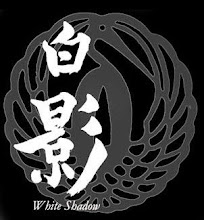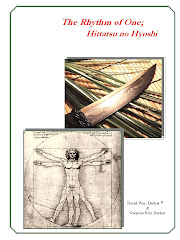
In our first book, The Rhythm of One, we described many different cuts:
snap cuts
push cuts
chopping cuts
continuous cutting
power slashes
For now I want to concentrate only on the psycho style power slash. We may discuss the other cuts in subsequent posts. For openers, the power slash will be most effective if it hits the target at the apex of the parabola or just after passing the apex. This point of travel coincides with the highest velocity of the blade. This is also where the knife rounds the corner, so to speak. For those of you who are martial artists, imagine the velocity of an ura ken (back knuckle strike) and how the snapping back of the fist is faster than the striking out. This is important to visualize as I will explain later under the topic of tip speed.
The focus of "The Edge of Functionality, Part 1 & 2" is defining the correct "approach angle" that should be used with each of the three knives described in Part One. I hope the following sketches will provide added clarity.
Knife Example Number 1: 
Knife example number one is the straight edged Morris tanto. As this blade approaches the target the tip should be cocked back slightly positing the blade at nearly 90 degrees to the target (and coincidentally about ninety degrees to your arm). Your arm, as it rounds the apex of the parabola beginning its retraction, imparts a curved movement to the straight blade. If by mistake, you strike the target at any angle approaching 180 degrees, blade extended straight out, a straight edge will tend to "bump" into the target and may chop through (if its really sharp) or (not being sharp) will bounce off rather than cut. Practice will quickly show you that the straight edged blade is the least forgiving of the three concerning the approach angle used for cutting.
Example Number 2: 
Knife example number two is a good neutral blade design, more flexible in the way it is used. Therefore this would be the best choice for a beginner or someone who is less interested in studying cutting dynamics and more interested in general utility purposes.
The Blackhawk™ Tatang’s medium curved blade makes cutting almost effortless. (I say almost because you still have to worry about a thing called hasuji.) You will note in these three sketches that as blade curvature increases, the approach angle also increases. This is what keeps the tip buried in the target rather than allowing it to pull out. The nearly vertical angle used with the Morris tanto becomes a nearly zero angle with DJ’s extremely curved fighter, example number three. Successfully cutting with that increasing curvature makes the arc of the blade and the hand become more parallel, ie following the same path.
Knife Example Number 3:
Number one and three establish the extreme design limits. Example number three has the most extreme curvature. The best approach angle for cutting with this knife is the one found to be least effective with a straight edged blade. As your blade approaches the target, the highly curved blade and your arm should be nearly in alignment with the blade cocked very little, if any. If you cock this blade back during the cut it is possible that the tip will never even c ome into contact with the target. This is because the blade edge, and the tip in particular, will be drawn away from the target as your arm rounds the curve and begins to retract. This will become painfully obvious in test cutting when, despite being within physical range, your knife fails to cut completely through the target. You keep moving closer but because your blade is cocked you continue to have problems cutting. Straighten out your arm/wrist and see what happens. In the next blog I will address hasuji and tip speed in more detail.
ome into contact with the target. This is because the blade edge, and the tip in particular, will be drawn away from the target as your arm rounds the curve and begins to retract. This will become painfully obvious in test cutting when, despite being within physical range, your knife fails to cut completely through the target. You keep moving closer but because your blade is cocked you continue to have problems cutting. Straighten out your arm/wrist and see what happens. In the next blog I will address hasuji and tip speed in more detail.







